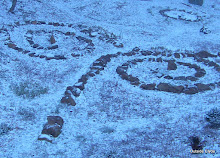
There are dapples of Anemones, it's true.

And this froth of white asteryness is new and decidedly different from two other white asters to be found among the blue asters of which there are so far just two, a big blue and a little blue.

Now the big blue one I know is Symphyotrichum novae-angliae, the New England Aster. It is big and of course easy to find in books and anywhere online, but there are few big blues compared to the enormous numbers of little blues.

A very late and valiant Rudbeckia hirta attempts a new hue in this blanket of blues. Absent its golden Solidago companions that have now faded, it strikes a lone and plaintive note, a mere yellow drop in a deep ocean of blue.

The little blue aster itself is not satisfied with one hue. The most common is the standard pale powder blue. The most dramatic is a deeper lavender blue. The most subtle is the near white with a barely discernible blush of the little blue's true hue.

This aster formerly known as the unidentified blue aster I have decided is Symphyotrichum cordifolium, as positive an identification among the blue asters as I can come to.






10 comments:
Wow!!!
I added our two rootballs of Calif's native blue aster, now also classified as Symphyotricum, to my garden this year to help keep things going in the autumn. Last November, I was moved by the sight of it blooming in huge drifts in a Berkeley garden. I'm guessing it will be more established in my garden next year. So far I'm not impressed.
Your soil is just so full of plants. Plants in mediterranean climates typically must grow farther apart to survive the long drought.
Don't be blue about not knowing exactly what aster you have. That hillside of blue asters looks like the sky has alighted on your mountain side. You could lie down there and feel like you are floating in the sky.
I had no idea that the taxonomists were tinkering with asters. They can't leave anything alone.
The last photo of the hillside under the trees with all that blue is stunning.
The masses of blue asters under the trees look beautiful. The punctuation marks of yellow and white just emphasize the dominance of blue even more. The colour drifts are reminiscent of spring.
Christopher, the more photos I see of your mountain and the flowers, the more I become convinced that you are living very, very near to Heaven.
A DOUBLE "WOW". Words cannot explain the joy of seeing the wonderment of your blues, not to mention the occasional white or yellow. I agree the more we see of your "home" the more we believe you are "in" heaven.
Thank you so much for sharing.
Chuck when they are happy the individual aster clumps can send up almost a dozen stems. Then of course they dump a ton of seed. The layering of plants here is intense that is for sure. One thing fades and something else replaces it.
Lisa the blue aster show is double this year compared to last.
Les did you know that Chrysanthemums are now Dendranthema? The taxonomists have been messing with the Asteraceae big time.
Hi Northern Shade. In spring we have a Daffodil and Spanish Bluebell, Hyacinthoides hispanica show followed by a whole range of spring wild flowers.
Kim and Lola there is no doubt that it is wonderful up here. I'm still adjusting to the colder end of cool, but it is worth it.
Something neat happens if you mouse the scroll bar on the right-side of your browser up and down really quick while the screen is centered over the Rudbeckia flowers in this post.
Chuck I am not sure if that Rudbeckia is waving at me or winking, a'la Sarah Palin style.
Whoa- just tried Chuck's dancing flowers trick and it made me dizzy. Blue, white and yellow are the colors I keep trying to get in the long fence border, Christopher. It's a lovely combination in your garden, no matter the identities.
Maybe you really are in the Garden of Eden and new species are being tried out before they get into general distribution ;-]
Annie at the Transplantable Rose
Post a Comment